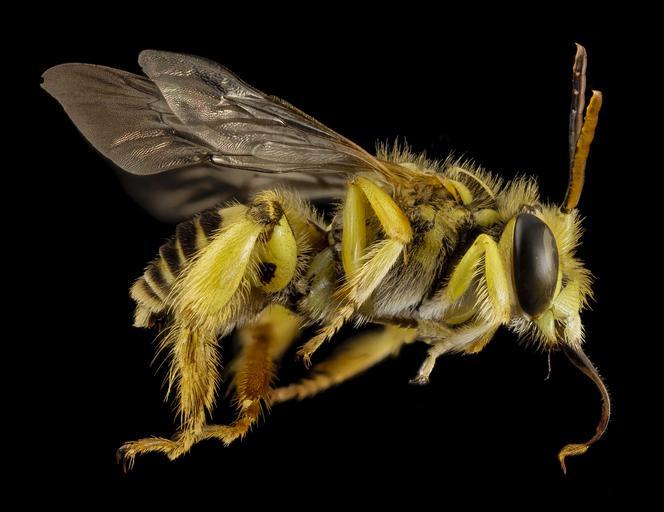MAKE A MEME
View Large Image

| View Original: | Caenonomada_unicalcarata,_m,_paraguay,_side_2014-08-07-20.51.07_ZS_PMax.jpg (4280x3301) | |||
| Download: | Original | Medium | Small | Thumb |
| Courtesy of: | www.flickr.com | More Like This | ||
| Keywords: tapinotaspidini bee bees taxonomy:binomial=caenomada unicalcarata taxonomy:binomial=caenomadaunicalcarata biml usgs usgsbiml droege brasil caenonomada oil collecting oilcollecting south america southamerica apidae black background animal pattern organic pattern photo border texture outdoor As the name implies this species from East of the Andes superficially resembles the parasitic bee genus Nomada. However for whatever reason they have chosen from the wardrobe of bee colors the same cloths they act quite differently. Of note is that both the males and females of this species gather oil in addition to the usual pollen and nectar. Check out the pointed tips of this male's antennae too! Another beauty from the Packer Lab at York University. ~~~~~~~~~~{{{{{{0}}}}}}~~~~~~~~~~ All photographs are public domain, feel free to download and use as you wish. Photography Information: Canon Mark II 5D, Zerene Stacker, Stackshot Sled, 65mm Canon MP-E 1-5X macro lens, Twin Macro Flash in Styrofoam Cooler, F5.0, ISO 100, Shutter Speed 200 The murmuring of bees has ceased; But murmuring of some Posterior, prophetic, Has simultaneous come,-- The lower metres of the year, When nature's laugh is done,-- The Revelations of the book Whose Genesis is June. -Emily Dickinson Want some Useful Links to the Techniques We Use? Well now here you go Citizen: Basic USGSBIML set up: www.youtube.com/watch?v=S-_yvIsucOY USGSBIML Photoshopping Technique: Note that we now have added using the burn tool at 50% opacity set to shadows to clean up the halos that bleed into the black background from "hot" color sections of the picture. www.youtube.com/watch?v=Bdmx_8zqvN4 PDF of Basic USGSBIML Photography Set Up: ftp://ftpext.usgs.gov/pub/er/md/laurel/Droege/How%20to%20Take%20MacroPhotographs%20of%20Insects%20BIML%20Lab2.pdf Google Hangout Demonstration of Techniques: plus.google.com/events/c5569losvskrv2nu606ltof8odo or www.youtube.com/watch?v=4c15neFttoU Excellent Technical Form on Stacking: www.photomacrography.net/ Contact information: Sam Droege sdroege@usgs.gov 301 497 5840 As the name implies this species from East of the Andes superficially resembles the parasitic bee genus Nomada. However for whatever reason they have chosen from the wardrobe of bee colors the same cloths they act quite differently. Of note is that both the males and females of this species gather oil in addition to the usual pollen and nectar. Check out the pointed tips of this male's antennae too! Another beauty from the Packer Lab at York University. ~~~~~~~~~~{{{{{{0}}}}}}~~~~~~~~~~ All photographs are public domain, feel free to download and use as you wish. Photography Information: Canon Mark II 5D, Zerene Stacker, Stackshot Sled, 65mm Canon MP-E 1-5X macro lens, Twin Macro Flash in Styrofoam Cooler, F5.0, ISO 100, Shutter Speed 200 The murmuring of bees has ceased; But murmuring of some Posterior, prophetic, Has simultaneous come,-- The lower metres of the year, When nature's laugh is done,-- The Revelations of the book Whose Genesis is June. -Emily Dickinson Want some Useful Links to the Techniques We Use? Well now here you go Citizen: Basic USGSBIML set up: www.youtube.com/watch?v=S-_yvIsucOY USGSBIML Photoshopping Technique: Note that we now have added using the burn tool at 50% opacity set to shadows to clean up the halos that bleed into the black background from "hot" color sections of the picture. www.youtube.com/watch?v=Bdmx_8zqvN4 PDF of Basic USGSBIML Photography Set Up: ftp://ftpext.usgs.gov/pub/er/md/laurel/Droege/How%20to%20Take%20MacroPhotographs%20of%20Insects%20BIML%20Lab2.pdf Google Hangout Demonstration of Techniques: plus.google.com/events/c5569losvskrv2nu606ltof8odo or www.youtube.com/watch?v=4c15neFttoU Excellent Technical Form on Stacking: www.photomacrography.net/ Contact information: Sam Droege sdroege@usgs.gov 301 497 5840 | ||||